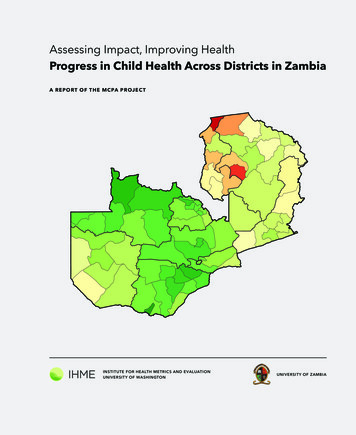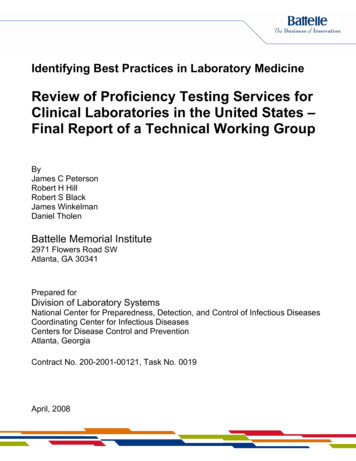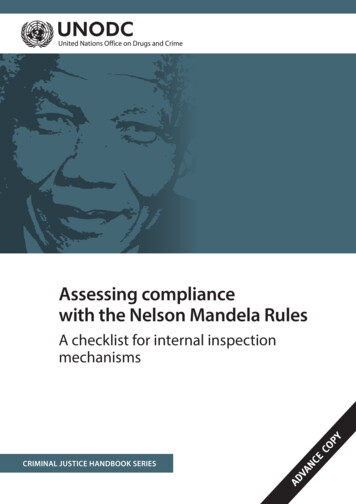
Transcription
Assessing Impact, Improving HealthProgress in Child Health Across Districts in ZambiaA R E PO RT O F T H E M CPA P ROJ E CTINSTITUTE FOR HEALTH METRICS AND EVALUATIONUNIVERSITY OF WASHINGTONUNIVERSITY OF ZAMBIA
This report was prepared by the Institute for Health Metrics andEvaluation (IHME) and the Department of Economics at theUniversity of Zambia (UNZA). This work is intended to provide information on levels and trends in under-5 mortality and coverageof key child health interventions across districts in Zambia. Theestimates may change following peer review. The contents of thispublication may not be reproduced in whole or in part withoutpermission from IHME.Institute for Health Metrics and Evaluation2301 Fifth Ave., Suite 600Seattle, WA 98121USATelephone: 1-206-897-2800Fax: 1-206-897-2899Email: icsandevaluation.orgPrinted in the United States 2014 Institute for Health Metrics and Evaluation
Assessing Impact, Improving HealthProgress in Child Health Across Districts in ZambiaA R E PO RT O F T H E M CPA P ROJ E CTTABLE O F CONTENTS3Acronyms4Terms and definitions5Executive summary6Introduction8Main findings12Conclusions and policy implications13References14Annex 1. Overview of the MCPA analytical approach and methods15 District profiles17Central province31Copperbelt province53Eastern province71Luapula province87Lusaka province97Northern province123North-western province139Southern province163Western province1
A B OU T IH METhe Institute for Health Metrics and Evaluation (IHME) is anindependent global health research center at the Universityof Washington that provides rigorous and comparable measurement of the world’s most important health problems andevaluates the strategies used to address them. IHME makesthis information freely available so that policymakers have theevidence they need to make informed decisions about how toallocate resources to best improve population health.To express interest in collaborating or request furtherinformation on the Malaria Control Policy Assessment (MCPA)project in Zambia, please contact IHME at:Institute for Health Metrics and Evaluation2301 Fifth Ave., Suite 600Seattle, WA 98121USATelephone: 1-206-897-2800Fax: 1-206-897-2899E-mail: icsandevaluation.orgA B OU T TH IS REP O RTAssessing Impact, Improving Health: Progress in Child HealthAcross Districts in Zambia provides the most up-to-date results from the MCPA project in Zambia, including district-leveltrends for a range of indicators and the impact of malaria control and other child health interventions on under-5 mortality.This report expands upon the 2011 report produced by IHMEand the University of Zambia (UNZA), Maternal and ChildHealth Intervention Coverage in Zambia: the HeterogeneousPicture.The MCPA project was led by Emmanuela Gakidou at IHMEand Felix Masiye at UNZA. Data collation was primarily con-ducted by Peter Hangoma and Peter Mulenga, researchers atthe Department of Economics at UNZA, and Frank Kukunga atthe Central Statistical Office (CSO). Trends in under-5 mortalitywere produced by Laura Dwyer-Lindgren at IHME, with contributions from Casey Olives of the University of Washington.At IHME, intervention coverage analyses were conducted byK. Ellicott Colson, with contributions from Laura Dwyer-Lindgren, Tom Achoki, Nancy Fullman, and Matthew Schneider(now at USAID). The causal attribution analysis was performedby Marie Ng and K. Ellicott Colson. This report was written byNancy Fullman, with contributions from William Heisel.ACKN OWLE DGMENTSThe MCPA project in Zambia is a collaboration between theDepartment of Economics at UNZA and IHME at the University of Washington. This project has benefited greatly from keyinputs and support from the Ministry of Health (MOH), the National Malaria Control Centre (NMCC), CSO, and the ChurchesHealth Association of Zambia (CHAZ), in Zambia. We are mostgrateful to these organizations, especially for their willingnessto facilitate data access and provide crucial content knowledge.We thank the MCPA Advisory Group, which consists ofinternational and local stakeholders who contributed towardrefining the project’s research concept and framework. Wealso thank the Malaria Control and Evaluation Partnership inAfrica (MACEPA) team in Zambia for facilitating data access. AtIHME, we wish to thank Heather Bonander, Annie Haakenstad,and Kelsey Pierce for managing the project; Patricia Kiyonofor managing the production of this report; Brian Childress,Adrienne Chew, and Kate Muller for editorial support; andRyan Diaz and Ann Kumasaka for graphic design. We thankSepo Kusiyo at UNZA for administrative support of the Zambian MCPA team.Funding for this research came from the Bill & MelindaGates Foundation.2
AcronymsAIDSAcquired immunodeficiency syndromeANC4Antenatal care, a minimum of four visitsBCGBacillus Calmette-Guérin vaccineCSOCentral Statistical OfficeDPT3Diphtheria-pertussis-tetanus vaccine (three doses)GPRGaussian Process RegressionHIVHuman immunodeficiency virusIHMEInstitute for Health Metrics and EvaluationIPTp2Intermittent preventive therapy in pregnancy, a minimum of two dosesIRSIndoor residual sprayingITNInsecticide-treated netJICAJapan International Cooperation AgencyMCPAMalaria Control Policy AssessmentMOHMinistry of HealthMSLMedical Stores LimitedNMCCNational Malaria Control CentrePCAPrincipal component analysisPMTCTPrevention of mother-to-child transmission of HIVSBASkilled birth attendanceUNZAUniversity of Zambia3
Terms and definitionsAll-cause under-5 mortality:the probability (expressed as the rate per 1,000 live births)that children born alive will die before reaching the age of 5yearsIntervention coverage:the proportion of individuals or households who received anintervention that they neededITN ownership:the proportion of households that own at least one ITNAntenatal care (ANC4) coverage:the proportion of women 15 to 49 years old who had four ormore antenatal visits at a health facility during pregnancyITN use by children under 5:the proportion of children under 5 years old who slept underan ITN the previous night, as reported by household headsBCG immunization coverage:the proportion of children under 5 years old who have beenvaccinated against tuberculosisMeasles immunization coverage:the proportion of children 12 to 59 months old who havereceived measles vaccinationChildhood underweight:the proportion of children under 5 years old who aretwo or more standard deviations below the internationalanthropometric reference population median of weight foragePentavalent immunization coverage:the proportion of children 12 to 59 months old who havereceived the pentavalent vaccine, which includes protectionagainst diphtheria-pertussis-tetanus (DPT), hepatitis B, andHaemophilus influenzae type bDPT3 coverage:the proportion of children 12 to 59 months old who havereceived three doses of the diphtheria-pertussis-tetanus(DPT) vaccinePolio immunization coverage:the proportion of children 12 to 59 months old who havereceived three doses of the oral polio vaccineExclusive breastfeeding coverage:the proportion of children who were exclusively breastfedduring their first six months after birthPrevention of mother-to-child transmission of HIV(PMTCT):the receipt of antiretroviral drugs as prophylaxis to reducethe risk of mother-to-child transmission of HIV among HIVpositive pregnant womenIndoor residual spraying coverage:the proportion of households that were sprayed with aninsecticide-based solution in the last 12 monthsSkilled birth attendance coverage:the proportion of pregnant women 15 to 49 years old whodelivered with a skilled birth attendant (a doctor, nurse,midwife, or clinical officer)Insecticide-treated net (ITN):a net treated with an insecticide-based solution that is usedfor protection against mosquitos that can carry malariaIntermittent preventive therapy in pregnancy, two doses(IPTp2):the proportion of pregnant women who received at least twotreatment doses of Fansidar (sulfadoxine/pyrimethamine) atantenatal care visits during pregnancy4
Executive summaryZambia has seen remarkable improvement in childhood survival over the past two decades. While the scale-up of malariacontrol interventions has been proposed as one of the biggest drivers behind that improvement, little research has beendone on how much of the reduction in childhood mortalitymay be attributed to malaria control and how much is the result of improvements in other child health interventions. Toaddress this knowledge gap, the University of Zambia (UNZA)and the Institute for Health Metrics and Evaluation (IHME)worked together on the Malaria Control Policy Assessment(MCPA) project. The goal of MCPA was to harness existingdata in Zambia and use rigorous statistical methods to quantify the impact of malaria control and other child healthinterventions on under-5 mortality trends across districts.We found that between 1990 and 2010, a combination ofrapidly scaled up child health interventions contributed to anadditional 11% of declines in under-5 mortality across Zambia.We looked at the combined effect of these interventions because the scale-up in ownership of insecticide-treated nets(ITNs) and use of indoor residual spraying (IRS) coincided withthe scale-up in three other key child health interventions: thepentavalent vaccine, exclusive breastfeeding, and services tohelp prevent mother-to-child transmission of HIV (PMTCT) athealth facilities. Isolating the specific impact of each intervention is not possible. Nevertheless, jointly, these interventionscontributed significantly to the reduction of under-5 mortalitythroughout the country.The MCPA project in Zambia produced district-level trendsfor key child health outcomes and interventions from 1990 to2010. This is the first time that annual estimates for under-5mortality and intervention coverage have been generated atthe district level. In this report, district profiles detail trendsin child health over time and benchmark the districts’ performance across indicators. With this information, local andnational policymakers and health officials can identify areasof successful health service delivery and detect early signs ofdeclining intervention coverage or stalled progress.This report shows that Zambia is succeeding on severalfronts in child health. First, countrywide reductions in under-5mortality were also accompanied by improvements in equityacross districts, as some of the districts with the highest mortality rates in 1990 recorded some of the greatest declines by2010. Second, coverage of key malaria control interventions,such as ITN ownership, increased dramatically in many districts. Third, the majority of districts were successful in quicklyincreasing coverage of the pentavalent vaccine after its introduction in 2005. Finally, rates of exclusive breastfeedingmarkedly rose in most districts, reflecting the country’s investments in improving child nutrition and breastfeedingpractices (WBTi 2008).These successes were accompanied by concerning trendsfor three key child health interventions in Zambia. First, mostdistricts saw a decline in the 2000s in antenatal care (ANC4),which is the proportion of pregnant women 15 to 49 yearsold who had four or more visits to a health facility duringpregnancy. This finding is particularly worrisome given thatdistricts generally increased levels of ANC4 during the 1990s.Second, coverage of polio immunization dropped in someof the districts that are considered at high risk for polio importation from neighboring countries. Third, in some areas ofZambia, skilled birth attendance declined to very low levels.Targeting these areas for improvement should be a priorityto ensure that the country’s achievements in child health continue into the present decade.With a focus on districts, findings from the MCPA projectin Zambia provide side-by-side comparisons of health performance over time, geography, and intervention type. Thechild health landscape is remarkably heterogeneous acrossdistricts, highlighting the need for continuous and timely assessment of district-level trends. With regularly collected andanalyzed district health information, policymakers can havethe evidence base to make targeted, data-driven decisions forachieving greater and more equitable health gains in Zambia.5
IntroductionOver the past decade, Zambia’s child health and development landscape has been substantially reshaped by newprograms, interventions, and priorities, including extensivemalaria control programs. In order to fully understand whathas contributed to Zambia’s progress in under-5 mortality, itis important to comprehensively account for all efforts to improve child health.In order to achieve these objectives, annual estimates ofdistrict-level trends from 1990 to 2010 were systematicallygenerated for each of the 72 districts in Zambia and acrossa range of key child health outcomes and interventions.Detailed descriptions of the findings for each district are presented in this report. District-level data can be downloadedfrom IHME’s Global Health Data Exchange: http://ghdx.healthmetricsandevaluation.org/.The MCPA project sought to use all available data sources,which are presented in Table 1. These analyses aimed to makefull use of the best available data in Zambia. Provincial estimates of under-5 mortality and intervention coverage werepreviously available, but for the first time district-level trendswere derived from these data sources using robust statisticalmethods. Annex 1 provides an overview of the analytical approach used to generate the estimates in this report.The MCPA project in Zambia had two main objectives:1) Determine what proportion of the decline in all-causeunder-5 mortality in Zambia was attributable to thescale-up of malaria control interventions, while accountingfor a range of other key child health interventions andnon-health factors.2) Assess this impact at the district level between 1990 and2010.BOX 1M A I N F I NDING S F RO M T H E MCPA PROJECT I N ZAMB I A Under-5 mortality substantially declined throughout Zambia from 1990 to 2010. Some of the greatestprogress was recorded in districts with the highest levels of under-5 mortality in 1990. Coverage of malaria control interventions rapidly increased, especially between 2005 and 2010.These gains in coverage were observed throughout Zambia. At the same time malaria interventions were scaled up, Zambia also successfully increased levels ofcoverage for three non-malaria child health interventions: the pentavalent vaccine, exclusive breastfeeding, and the availability of PMTCT services at health facilities. Together, these rapidly scaled up interventions were responsible for an 11% reduction in the under-5mortality rate from 2000 to 2010. Sustaining high coverage of these interventions is critical for childhealth in Zambia. Amidst the country’s health successes, some worrisome trends emerged that warrant attention. Mostdistricts saw sharp declines in antenatal care visits during the 2000s, and skilled birth attendance fellto very low levels in several places. Others experienced a minimal scale-up of the pentavalent vaccine,and some of the high-risk districts for polio importation recorded drops in polio immunization coverage. Addressing these gaps in health service provision is crucial to maintaining the country’s gainsin child health.6
Table 1. Data sources used in the MCPA projectDATA SOU RC EYE A R S R E P R E SE N TE DSURVEYSDemographic and Health Survey (DHS)1992, 1996-1997, 2001-2002, 2007Malaria Indicator Survey (MIS)2006, 2008, 2010, 2012Multiple Indicator Cluster Survey (MICS)1999Living Conditions Monitoring Survey (LCMS)1996, 1998, 2002-2003, 2004-2005, 2006, 2010Health Facility CensusJapan International Cooperation Agency (JICA) (2005-2006)Sexual Behavior Survey (SBS)2005, 2009Household Health Coverage Survey2008Netmark Survey reports2000, 2004POPULATION CENSUSESNational census1990, 2000, 2010ADMINISTRATIVE SOURCESHealth Management Information System (HMIS)2000-2008; 2009Malaria intervention databasesNational Malaria Control Centre (NMCC) (2005-2010)Facility-level PMTCT servicesNational AIDS Council quarterly status report (2005-2009)HIV/AIDS projectionsCentral Statistical Office (CSO) (2005)Drug supply and delivery recordsMedical Stores Limited (MSL) (2007-2010)Precipitation dataGlobal Precipitation Climatology Centre (1986-2012)Malaria endemicity (PfPR2-10)Malaria Atlas Project (2007, 2010)An earlier version of this report was published in 2011, Maternal and Child Health Intervention Coverage in Zambia: theHeterogeneous Picture, and focused on intervention coveragetrends between 1990 and 2010. The present report provides abroader range of updated results, including under-5 mortalityand coverage of the pentavalent vaccine, and drills deeperinto Zambia’s trends in child health at the district level. Further, the present report quantifies the contribution of malariacontrol and other key child health interventions to Zambia’sreductions in under-5 mortality.7
Main findingsUnder-5 mortality declines observed across districts,accompanied by reductions in inequitiesout Zambia after 2000, with most of the gains occurring since2005. Nationally, the proportion of households that eitherowned at least one ITN or received IRS increased from 8% in2000 to 37% in 2005 and then rapidly climbed to 71% in 2010.Coverage of intermittent preventive therapy in pregnancy(IPTp2) quickly rose from 16% in 2002 to around 70% in 2008.In the early 2000s, coverage of malaria control interventions was very low throughout Zambia, with only a few districtsbenefiting from ITN pilot programs and early implementationof IRS. By 2010, however, all districts had coverage levels exceeding 55% for having either ITNs or IRS. Figure 2 shows therise in coverage of malaria control from 2000 to 2010.Districts saw a wide variety of trends in IPTp2 coverageduring the 2000s. IPTp2 levels rose rapidly in many districtsthroughout the 2000s. Others saw an increase in coverageand then a leveling off by 2010. A third group of districts experienced substantial declines in coverage during the late2000s. Last, a subset of districts recorded very small changesin IPTp2 coverage during this period.Zambia’s National Malaria Strategic Plan, 2006-2010 setseveral malaria intervention coverage targets to achieve by2010, including (1) 80% of households with at least threeITNs; (2) 85% of eligible households in 15 target districtshaving received IRS; (3) 80% of pregnant women receiving 2 doses of Fansidar/SP (IPTp2); and (4) 80% of childrenunder 5 years old sleeping under an ITN or residing in a housewith IRS (MOH 2006). These targets were very ambitious, anddespite marked progress since 2000, no district achieved allfour targets in 2010. Only five districts reached two of the fourtargets. Table 2 displays the 28 districts that met one or moreof these targets in 2010. The target that was most frequentlymet was the third target, with 16 districts achieving at least80% IPTp2 coverage in 2010.Zambia made substantial progress in improving child survival between 1990 and 2010. At the national level, all-causeunder-5 mortality decreased by 37%, from 174 deaths per1,000 live births in 1990 (95% CI: 168, 181) to 109 in 2010(95% CI: 104, 116). All districts saw reductions in their levelsof under-5 mortality during this time. Moreover, many of thedistricts with the highest levels of under-5 mortality in 1990showed the greatest declines by 2010. Figure 1 depicts howthe range in under-5 mortality across districts has becomenarrower.In 1990, levels of under-5 mortality spanned from 125deaths per 1,000 live births (95% CI: 97, 161) to 276 (95%CI: 220,338) in different districts. Twenty years later, this gapsubstantially tightened, with a range of 83 deaths per 1,000live births (95% CI: 60, 113) to 150 (95% CI: 109, 203). The difference between the district with the highest level of under-5mortality and the lowest was more than halved from 1990 to2010 (dropping from a difference of 151 to 67), illustratinghow Zambia’s progress in reducing under-5 mortality was alsoassociated with decreased health inequities across districts.Despite these improvements, it is worth noting that somedistricts and regions documented less progress. Districts inNorthern province had very high levels of under-5 mortalityin 1990, and though many recorded large declines, theirrates still remained among the highest in the country in 2010(greater than 120 deaths per 1,000 live births). Additionalefforts to reduce under-5 mortality need to be prioritized inthese districts.Malaria interventions are rapidly scaled up in Zambia,but most districts fall short of national targetsCoverage of malaria interventions greatly increased through-Figure 1. District-level estimates of all-cause under-5 mortality for 1990, 2000, and 2010199020002010280240200160120808
Figure 2. Percentage of households covered by an ITN, IRS, or both interventions, in 2000, 2005, and 2010200020051002010806040200Table 2. District attainment of 2010 malaria intervention targetsGEOGRAPH Y M A LA R I A I N TE RVE N TI O N TA R G E TSPROVINCEDISTRICTOWNERSHIPOF 1 ITN*IRSCOVERAGE**IPTP, 2 ungwiNakondeLivingstoneUNDER-5 ITNUSE OR otes:* The NMCC goal was ownership of at least three ITNs by 2010.** The NMCC goal was 85% coverage of eligible households by 2010. Based on MCPA analyses, no district reached 85% IRS coverage;however, household eligibility could not be ascertained.9
Scale-up of the pentavalent vaccine varies, polioimmunization falls in some areasJust looking at the national level, trends in immunization coverage generally point to progress. But at the district level, wesee a wide range of trends, with progress, stagnation, andtroubling declines in coverage.The pentavalent vaccine was formally introduced in Zambiain 2005, and the country achieved 67% coverage in 2010. Atthe district level, coverage of the pentavalent vaccine rangedfrom as low as 22% (95% CI: 8%, 44%) to as high as 90% (95%CI: 81%, 96%) in 2010, with some districts showing strongprogress since 2005 and others showing minimal gains in coverage. Figure 3 depicts this range for pentavalent coveragein 2010. Many of the largest gains were observed in Easternprovince, while several districts in North-western provincecontinued to have some of the lowest levels of pentavalentcoverage in 2010. Identifying how to improve the delivery oruptake of the pentavalent vaccine for these districts ought tobe a priority.In 2010, polio immunization coverage reached 81% atthe national level. However, coverage varied greatly acrossdistricts, ranging from 24% (95% CI: 10%, 42%) to 99% (95%CI: 98%, 100%). Zambia’s polio-free certification was acceptedin 2005, but several districts that border the Democratic Republic of Congo (DRC) and Angola are considered at highrisk for polio importation from these countries (WHO 2011).Some of these high-risk districts recorded declining coverageof polio immunization during the 2000s and had some of thelowest levels of coverage in Zambia in 2010. If Zambia is tooptimally protect itself from imported polio, deliberate effortsare needed to ensure that levels of polio immunization aresustained at high levels in high-risk areas.Figure 3. The proportion of children who received thepentavalent vaccine in 2010100806040200Coverage of antenatal care substantial declined whileskilled birth attendance gradually increasedAfter maintaining moderately high levels of ANC4 through the1990s, coverage in Zambia declined during the 2000s, dropping to 37% in 2010. At the same time, skilled birth attendance(SBA) coverage gradually increased, rising to 55% in 2010.For most districts, ANC4 coverage reached its highestlevels between 1990 and 2000, after which coverage markedlyfell. Figure 4 shows ANC4 coverage in most districts droppingfrom higher levels (green) to much lower ones (shades oforange to red). Understanding why so many districts experienced such sharp declines in antenatal care should be a highpriority in Zambia. It is important to note that a few districtsdid increase ANC4 coverage during this time. It is likely thatmuch could be learned from these districts about approachesto ANC4 provision and support of health-seeking behaviors.Trends in SBA coverage widely varied across districts, asdid the range in levels of coverage throughout the country. In2010, SBA coverage ranged from less than 1% to 98% (95%CI: 91%, 100%). About five districts had very low levels of SBAFigure 4. Coverage of four or more antenatal care visits (ANC4) in 2000, 2005, and 201020002005201010080604020010
during the 1990s but then brought coverage to above thenational average in 2010. Approximately 10 recorded steadygains in SBA during the 1990s before sharply falling to levelsbelow 20%. A number of districts had consistently low levelsover the two decades, while a few maintained high coverage.Zambia would likely benefit from further investigation into thedistrict’s differences in skilled birth attendance trends, especially to determine ways to improve coverage in places whereSBA appears to be minimal.After accounting for other factors (including socioeco omic indicators), rapidly scaled up interventions were signnificantly associated with Zambia’s reductions in all-causeunder-5 mortality. If the coverage of these interventions hadremained at levels observed in 2000, under-5 mortality wouldhave been 11% higher in 2010 (124 deaths per 1,000 livebirths (95% CI: 118, 129)) than what was actually observed forthat year (109 deaths per 1,000 live births (95% CI: 104, 116))(Figure 6).Breastfeeding increased to high levelsFigure 6. Trends in under-5 mortality as observedand predicted in the absence of rapidly scaled upinterventions, 1990-2010Rapid scale-up of key child health interventionscontributes to declines in under-5 mortalityTo assess the impact of malaria control on under-5 mortalityin Zambia, the MCPA research team conducted a causal attribution analysis that included a full range of child healthinterventions and non-health factors. More details on themethods and statistical models used can be found in Annex 1.The team found that Zambia had scaled up several interventions at the same time. Figure 5 shows how gains in ITNand IRS coverage coincided with rising levels of the pentavalent vaccine, exclusive breastfeeding, and the availabilityof PMTCT in health facilities. It was statistically impossibleto tease out the individual effects of these interventions onunder-5 mortality. Instead, researchers created a compositeindicator of “rapidly scaled up interventions.”Figure 5. The scale-up of malaria control interventionsand a subset of key child health interventions32. 5Percent (%)802601. 540120.50No. of facilities with PMTCT per capita*100019901995200020052010ITN ownership and/or IRSPentavalent vaccineExclusive breastfeedingFacilities offering PMTCT per capita** Children under 1 year old11180170All cause under 5 mortalityRates of exclusive breastfeeding rose steadily throughout the1990s and 2000s before reaching 80% nationally in 2010. Mostdistricts followed this trend, but there were some notable exceptions. Some districts experienced an earlier scale-up ofexclusive breastfeeding, recording their highest levels in theearly 2000s, but saw coverage quickly decline by 2010. A fewdistricts, mostly in Eastern province, consistently trailed thenational scale-up of exclusive breastfeeding, barely reaching60% in rved under 5 mortalityPredicted under 5 mortality without scale upUnder 5 deaths averted due to scale upThis finding suggests that the rapid scale-up of these fivematernal and child health interventions hastened the declineof under-5 mortality by 1% per year. It is important to note thatunder-5 mortality rates would have continued to decline inZambia between 2000 and 2010, even without the scale-up ofthese interventions. In fact, under-5 mortality decreased 14%between 1990 and 2000, dropping from 174 deaths per 1,000live births (95% CI: 168, 181) to 149 in 2000 (95% CI: 144, 156).Given the declines that Zambia experienced in under-5 mortality from 1990 to 2000, we would have predicted an 18%decrease in under-5 mortality between 2000 and 2010. Instead, with the scale-up of these five interventions, the countryrecorded a 26% decline during this time. In other words, thesimultaneous scale-up of ITNs, IRS, the pentavalent vaccine,exclusive breastfeeding, and PMTCT services accelerated thedeclines in under-5 mortality by an additional 1% per year.
Conclusions and policy implicationsBetween 1990 and 2010, the health landscape in Zambiamarkedly changed, and for the most part, these changes reflect progress and service delivery success throughout thecountry. Under-5 mortality substantially decreased at the national level, and the gap between districts with the highest andlowest under-5 mortality substantially decreased. These declines in under-5 mortality can be tied to Zambia’s successfulefforts in expanding coverage for a subset of child healthinterventions: ITN ownership, IRS, the pentavalent vaccine, exclusive breastfeeding, and the availability of PMTCT services.These five interventions were rapidly scaled up during the2000s and jointly contributed to an additional 11% reductionin all-cause under-5 mortality in Zambia beyond what wouldhave been expected based on the country’s trends in under-5mortality during the 1990s. T
tributions from Casey Olives of the University of Washington. At IHME, intervention coverage analyses were conducted by K. Ellicott Colson, with contributions from Laura Dwyer-Lind-gren, Tom Achoki, Nancy Fullman, and Matthew Schneider (now at USAID). The causal attribution analysis was performed by Marie Ng and K. Ellicott Colson.










